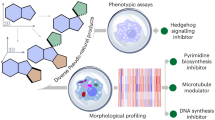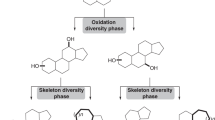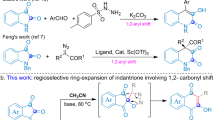Abstract
Organic chemists are now able to synthesize small quantities of almost any known natural product, given sufficient time, resources and effort. However, translation of the academic successes in total synthesis to the large-scale construction of complex natural products and the development of large collections of biologically relevant molecules present significant challenges to synthetic chemists. Here we show that the application of two nature-inspired techniques, namely organocascade catalysis and collective natural product synthesis, can facilitate the preparation of useful quantities of a range of structurally diverse natural products from a common molecular scaffold. The power of this concept has been demonstrated through the expedient, asymmetric total syntheses of six well-known alkaloid natural products: strychnine, aspidospermidine, vincadifformine, akuammicine, kopsanone and kopsinine.
This is a preview of subscription content, access via your institution
Access options
Subscribe to this journal
Receive 51 print issues and online access
$199.00 per year
only $3.90 per issue
Buy this article
- Purchase on Springer Link
- Instant access to full article PDF
Prices may be subject to local taxes which are calculated during checkout







Similar content being viewed by others
References
Walji, A. & MacMillan, D. W. C. Strategies to bypass the Taxol problem. Enantioselective cascade catalysis, a new approach for the efficient construction of molecular complexity. Synlett 1477–1489 (2007)
Va, P., Campbell, E. L., Robertson, W. M. & Boger, D. L. Total synthesis and evaluation of a key series of C5-substituted vinblastine derivatives. J. Am. Chem. Soc. 132, 8489–8495 (2010)
Huang, Y., Walji, A. M., Larsen, C. H. & MacMillan, D. W. C. Enantioselective organo-cascade catalysis. J. Am. Chem. Soc. 127, 15051–15053 (2005)
Simmons, B., Walji, A. & MacMillan, D. W. C. Cycle-specific organocascade catalysis: application to olefin hydroamination, hydro-oxidation, and amino-oxidation, and to natural product synthesis. Angew. Chem. Int. Ed. 48, 4349–4353 (2009)
Dewick, P. M. Medicinal Natural Products: A Biosynthetic Approach 3rd edn (Wiley, 2008)
Corey, E. J., Imai, N. & Pikul, S. Catalytic enantioselective synthesis of a key intermediate for the synthesis of prostanoids. Tetrahedr. Lett. 32, 7517–7520 (1991)
Kuehne, M. E., Wang, T. & Seraphin, D. The total synthesis of (±)-mossambine. Synlett 557–558 (1995)
Bandarage, U. K., Kuehne, M. E. & Glick, S. D. Total syntheses of racemic albifloranine and its anti-addictive congeners, including 18-methoxycoronaridine. Tetrahedron 55, 9405–9424 (1999)
Grondal, C., Jeanty, M. & Enders, D. Organocatalytic cascade reactions as a new tool in total synthesis. Nature Chem. 2, 167–178 (2010)
Bonjoch, J. & Sole, D. Synthesis of strychnine. Chem. Rev. 100, 3455–3482 (2000)
Sirasani, G., Paul, T., Dougherty, W., Kassel, S. & Andrade, R. B. Concise total syntheses of (±)-strychnine and (±)-akuammicine. J. Org. Chem. 75, 3529–3532 (2010)
Hudlicky, T. & Reed, J. W. The Way of Synthesis: Evolution of Design and Methods for Natural Products (Wiley-VCH, 2007)
Jones, S. B., Simmons, B. & MacMillan, D. W. C. Nine-step enantioselective total synthesis of (+)-minfiensine. J. Am. Chem. Soc. 131, 13606–13607 (2009)
Thomas, P. J. & Stirling, C. J. M. Elimination and addition reactions. Part 34. The effect of activating group and medium on leaving group rank in elimination from carbanions. J. Chem. Soc. Perkin Trans. II 11, 1130–1134 (1978)
Gatta, F. & Misiti, D. Selenium dioxide oxidation of tetrahydro-β-carboline derivatives. J. Heterocycl. Chem. 24, 1183–1187 (1987)
Prashad, M., Lavecchia, L., Prasad, K. & Repic, O. A convenient synthesis of 3-substituted 1H-indoles. Synth. Commun. 25, 95–100 (1995)
Oestreich, M. Ed. The Mizoroki–Heck Reaction (Wiley, 2009)
Anet, F. A. L. & Robinson, R. Conversion of the Wieland–Gumlich aldehyde into strychnine. Chem. Ind. 245. (1953)
Knight, S. D. & Overman, L. E. Enantioselective total synthesis of (−)-strychnine. J. Am. Chem. Soc. 115, 9293–9294 (1993)
Mori, M., Nakanishi, M., Kajishima, D. & Sato, Y. A novel and general synthetic pathway to Strychnos indole alkaloids: total syntheses of (−)-tubifoline, (−)-dehydrotubifoline, and (−)-strychnine using palladium-catalyzed asymmetric allylic substitution. J. Am. Chem. Soc. 125, 9801–9807 (2003)
Sole, D. et al. Total synthesis of (−)-strychnine via the Wieland–Gumlich aldehyde. Angew. Chem. Int. Ed. 38, 395–397 (1999)
Martin, D. B. & Vanderwal, C. D. A synthesis of strychnine by a longest linear sequence of six steps. Chem. Sci. 2, 649–651 (2011)
Sole, D., Diaba, F. & Bonjoch, J. Nitrogen heterocycles by palladium-catalyzed cyclization of amino-tethered vinyl halides and ketone enolates. J. Org. Chem. 68, 5746–5749 (2003)
Jeffery, T. On the efficiency of tetraalkylammonium salts in Heck type reactions. Tetrahedron 52, 10113–10130 (1996)
Marino, J. P., Rubio, M. B., Cao, G. F. & de Dios, A. Total synthesis of (+)-aspidospermidine: a new strategy for the enantiospecific synthesis of Aspidosperma alkaloids. J. Am. Chem. Soc. 124, 13398–13399 (2002)
Kobayashi, S., Peng, G. & Fukuyama, T. Efficient total syntheses of (±)-vincadifformine and (−)-tabersonine. Tetrahedr. Lett. 40, 1519–1522 (1999)
Hajicek, J. A review on recent developments in syntheses of the post-secodine indole alkaloids. Part I: The primary alkaloid types. Collect. Czech. Chem. Commun. 69, 1681–1767 (2004)
Cho, H.-K., Tam, N. T. & Cho, C. G. Total synthesis of (±) aspidospermidine starting from 3-ethyl-5-bromo-2-pyrone. Bull. Korean Chem. Soc. 31, 3382–3384 (2010)
Gnecco, D. et al. Synthesis of an aspidosperma alkaloid precursor: synthesis of (+)-aspidospermidine. Arkivoc 2003 (xi),. 185–192 (2003)
Kozmin, S. A., Iwama, T., Huang, Y. & Rawal, V. H. An efficient approach to Aspidosperma alkaloids via [4 + 2] cycloadditions of aminosiloxydienes: Stereocontrolled total synthesis of (±)-tabersonine. Gram-scale catalytic asymmetric syntheses of (+)-tabersonine and (+)-16-methoxytabersonine. Asymmetric syntheses of (+)-aspidospermidine and (−)-quebrachamine. J. Am. Chem. Soc. 124, 4628–4641 (2002)
Kuehne, M. et al. Application of ferrocenylalkyl chiral auxiliaries to syntheses of indolenine alkaloids: enantioselective syntheses of vincadifformine, ψ- and 20-epi-ψ-vincadifformines, tabersonine, ibophyllidine, and mossambine. J. Org. Chem. 63, 2172–2183 (1998)
Magnus, P. & Brown, P. Total synthesis of (−)-kopsinilam, (−)-kopsinine, and the bis-indole alkaloids (−)-norpleiomutine and (−)-pleiomutine. J. Chem. Soc. Chem. Commun. 184–186 (1985)
Kuehne, M. E. & Seaton, P. J. Studies in biomimetic alkaloid syntheses. 13. Total syntheses of racemic aspidofractine, pleiocarpine, pleiocarpinine, kopsinine, N-methylkopsanone, and kopsanone. J. Org. Chem. 50, 4790–4796 (1985)
Wenkert, E. & Pestchanker, M. J. A formal total synthesis of kopsinine. J. Org. Chem. 53, 4875–4877 (1988)
Ogawa, M., Kitagawa, Y. & Natsume, M. A high-yield cyclization reaction for the framework of aspidosperma alkaloids synthesis of (±)-kopsinine and its related alkaloids. Tetrahedr. Lett. 28, 3985–3986 (1987)
Gallagher, T. & Magnus, P. Synthesis of (±)-kopsanone and (±)-10,22-dioxokopsane, heptacyclic indole alkaloids. J. Am. Chem. Soc. 105, 2086–2087 (1983)
Kump, C., Dugan, J. J. & Schmid, H. Ringschlussreaktionen an Pleiocarpa-Alkaloiden. Helv. Chim. Acta 49, 1237–1243 (1966)
Magnus, P., Payne, A. H. & Hobson, L. Synthesis of the kopsia alkaloids (±)-11,12-demethoxylahadinine B, (±)-kopsidasine and (±)-kopsidasine-N-oxide. Tetrahedr. Lett. 41, 2077–2081 (2000)
Acknowledgements
Financial support was provided by NIHGMS (R01 GM078201-05) and gifts from Merck, Bristol-Myers Squibb and Abbott. S.B.J. and B.S. thank Bristol-Myers Squibb and Merck, respectively, for graduate fellowships.
Author information
Authors and Affiliations
Contributions
S.B.J., B.S. and A.M. participated in the performance and analysis of the experiments. S.B.J., B.S., A.M. and D.W.C.M. designed the experiments. S.B.J. and D.W.C.M. wrote the paper.
Corresponding author
Ethics declarations
Competing interests
The authors declare no competing financial interests.
Supplementary information
Supplementary Information
The file contains Supplementary Text and additional references. (PDF 10384 kb)
Rights and permissions
About this article
Cite this article
Jones, S., Simmons, B., Mastracchio, A. et al. Collective synthesis of natural products by means of organocascade catalysis. Nature 475, 183–188 (2011). https://doi.org/10.1038/nature10232
Received:
Accepted:
Published:
Issue Date:
DOI: https://doi.org/10.1038/nature10232
This article is cited by
-
Collective total synthesis of stereoisomeric yohimbine alkaloids
Nature Communications (2024)
-
A bridged backbone strategy enables collective synthesis of strychnan alkaloids
Nature Chemistry (2023)
-
Asymmetric organocatalysis: from a breakthrough methodology to sustainable catalysts and processes
Russian Chemical Bulletin (2023)
-
Collective synthesis of acetylenic pharmaceuticals via enantioselective Nickel/Lewis acid-catalyzed propargylic alkylation
Nature Communications (2021)
-
Enantioselective total syntheses of (+)-stemofoline and three congeners based on a biogenetic hypothesis
Nature Communications (2020)
Comments
By submitting a comment you agree to abide by our Terms and Community Guidelines. If you find something abusive or that does not comply with our terms or guidelines please flag it as inappropriate.



